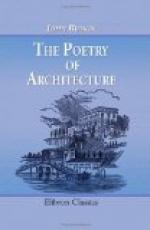[Footnote 27: As in a beautiful example in Brasenose College, Oxford.]
[Footnote 28: The portico of the [old] Schools and the inner courts of Merton and St. John’s Colleges, Oxford; an old house at Charlton, Kent; and Burleigh House, will probably occur to the mind of the architect, as good examples of the varieties of this mixed style.]
155. Now, all this is utterly barbarous as architecture; but, with the exception of the chimneys, it is not false in taste; for it was originally intended for retired and quiet habitations in our forest country, not for conspicuous palaces in the streets of the city; and we have shown, in speaking of green country, that the eye is gratified[29] with fantastic details; that it is prepared, by the mingled lights of the natural scenery, for rich and entangled ornament, and would not only endure, but demand, irregularity of system in the architecture of man, to correspond with the infinite variety of form in the wood architecture of nature. Few surprises can be imagined more delightful than the breaking out of one of these rich gables, with its decorated entrance, among the dark trunks and twinkling leaves of forest scenery. Such an effect is rudely given in fig. 12. We would direct the attention chiefly to the following points in the building:—
[Footnote 29: [i.e. when the spectator is surrounded by woodland scenery. Vide ante, Sec. 88.]]
156. First, it is a humorist, an odd, twisted, independent being, with a great deal of mixed, obstinate, and occasionally absurd originality. It has one or two graceful lines about it, and several harsh and cutting ones; it is a whole, which would allow of no unison with any other architecture; it is gathered in itself, and would look very ugly indeed, if pieces in a purer style of building were added. All this corresponds with points of English character, with its humors, its independency, and its horror of being put out of its own way.




